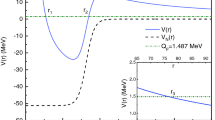Abstract
The phenomenon of proton emission is treated as a process of asymmetric fission through a one-dimensional potential barrier developed due to combined effects of the Coulomb potential, centrifugal potential and various renormalization processes. The barrier is simulated to an asymmetric, smooth and analytically solvable potential with adjustable depth, shape and range. The half-lives of proton emitters in the mass range A = 105–171 have been calculated using exact expression for the transmission coefficients. Good agreement with the experimental data is obtained by the adjustment of just one parameter in all the cases.
Similar content being viewed by others
References
S Hofmann, Particle emission from nuclei edited by M Ivascu and D N Poenaru (CRC, Boca Raton, FL 2, 1989) vol. 2, chap. 2
S Aberg, P B Semmes and W Nazarewicz, Phys. Rev. C56, 1762 (1997)
B Buck and A C Merchant, Phys. Rev. C45, 1688 (1992)
A I Baz, Ya B Zel’dovich and A M Perelomov, Scattering reactions and decay in nonrelativistic quantum mechanics (Israel Program for Scientific translations, Jerusalem, 1969)
S A Gurvitz and G Kalbermann, Phys. Rev. Lett. 59, 262 (1987)
M Goncalves and S B Duarte, Phys. Rev. C48, 2409 (1993)
O Rodriguez, F Guzmann, S B Duarte, O A P Tavares, F Garcia and M Goncalves, Phys. Rev. C59, 253 (1999)
V M Strutinsky, Nucl. Phys. A95, 420 (1967)
F Guzmann, M Goncalves, O A P Tavares, S B Duarte, F Garcia and O Rodriguez, Phys. Rev. C59, R 2339 (1999)
G Shanmugam and B Kamalaharan, Phys. Rev. C38, 1377 (1988)
B Sahu, S K Agarwalla and C S Shastry, J. Phys A: Math. Gen. 35, 4349 (2002)
B Sahu, G S Mallik and S K Agarwalla, Nucl. Phys. A727, 299 (2003)
Y J Shi and W J Swiatecki, Nucl. Phys. A438, 45 (1985)
A S Jenson and C Y Wong, Phys. Rev C1, 1321 (1970)
G Shanmugam and B Kamalaharan, Phys. Rev. C41, 1742 (1990)
Shanmugam et al, in Proc. DAE-BRNS Symp. on Nuclear Physics, India B43, 300 (2000)
J R Nix, Ann. Phys. 41, 52 (1967)
J N Ginocchio, Ann. Phys. 152, 203 (1984)
D N Poenaru, W Greiner, M Ivascu, D Mazilu and I H Plonski, Z. Phys. A325, 435 (1986)
F D Becchetti Jr and G W Greenlees, Phys. Rev. 182, 1190 (1969)
M Balasubramanium and N Arunachalam, Phys. Rev. C71, 014603 (2005)
S B Duarte, O A P Tavares and M Goncalves, Phys. Rev. C56, 3414 (1997)
Zafar Ahmed, Phys. Rev. A47, 4761 (1993)
Author information
Authors and Affiliations
Corresponding author
Rights and permissions
About this article
Cite this article
Mehrotra, I., Prakash, S. Proton radioactivity with analytically solvable potential. Pramana - J Phys 70, 101–111 (2008). https://doi.org/10.1007/s12043-008-0008-1
Received:
Revised:
Accepted:
Published:
Issue Date:
DOI: https://doi.org/10.1007/s12043-008-0008-1




